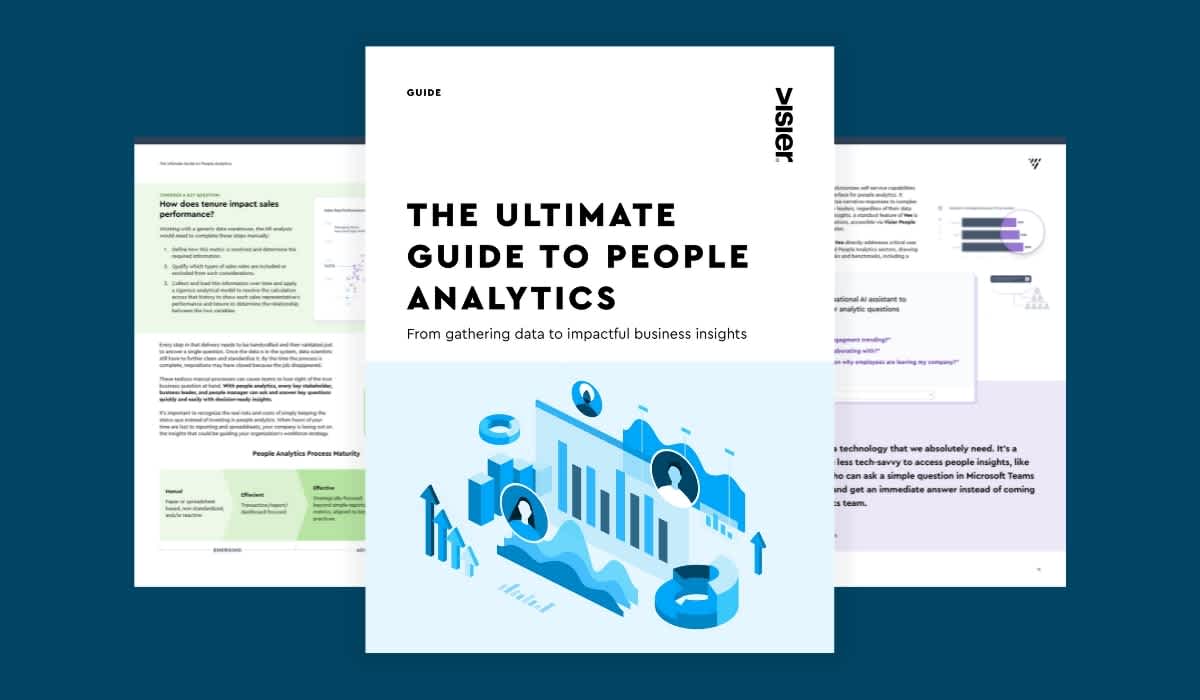Leverage Social Proof and 6 More Insider Tips for Sharing People Analytics With Leaders
Merck's Jeremy Shapiro on how to leverage people analytics insights for compelling storytelling that moves business leaders to action. Read his seven top tips here.

We all agree that people analytics provides powerful insights—however, the more significant impact of people analytics (PA) happens when business leaders use the insights PA provides to make critical decisions that resonate throughout the organization.
So, how can PA leaders best share the people data insights they uncover with senior leaders in a concise and compelling way? Jeremy Shapiro, AVP, Human Resources, Workforce Analytics at Merck, shared these seven tips at our recent conference.

Jeremy Shapiro presents at Visier's annual customer conference, Outsmart, in 2024
1. Start from the beginning
Whenever we share information with others there is a tendency to assume too much. While the data may be very familiar to you, it’s likely not as familiar to your audience. Try not to jump into the middle of the data narrative before setting the stage in terms of the data’s relevance.
As Shapiro says, that’s like “starting in the middle of a book while the person I’m sitting with is on chapter one.” He says, while it may sound a little silly, when he works with his team he encourages them to spin a tale that starts from the beginning. “Don’t say it out loud, but just in your head—‘once upon a time’.”
2. Know your audience
One size does not fit all when it comes to sharing PA data and its implications. Presentations and discussions should be adapted to fit the style and preferences of the leaders you’re addressing. Your approach, presentation, and style will likely differ significantly across industries—or even departments in your organization.
“If you only have a half hour with an executive, you’ve got two options: you can explain all of the stuff on the page, or you can actually talk about the thing that you know the executive wants to talk about. That takes away friction for your audience.”
3. Keep points crisp
Be clear and focused when presenting PA data. It’s important to be concise and to the point to ensure that these discussions are impactful and that they drive the desired action or decision from leaders.
Keep in mind that you often have to back way up to create a narrative that will be compelling and that will capture attention.
For example, Shapiro suggests, saying something like: “A few weeks ago we were in a conversation and you were very concerned that turnover is causing performance issues in this team. I’d like to walk you through a few numbers and get your reaction and feedback on what you see here.” That’s the kind of crisp methodology, he says, that can be very important in driving your points home.
4. Provide context
Without sufficient context, your information will lack relevance. The news media slogan for Bloomberg is, Context changes everything and that’s true here as well. Help your audience understand the data by setting the scene that will help them evaluate the information more effectively.
For instance, Shapiro suggests, offering comparative data points to historical trends, or explaining the significance of data points to help leaders make informed decisions. Don’t assume that they will automatically understand the relevance of what you’re presenting to them, it’s the ideal opportunity to practice your data storytelling skills.

5. Reduce cognitive load
Keep cognitive load in mind when presenting complex data. Simplify the information you’re presenting and reduce the amount of data you’re presenting to focus on what is likely to be most relevant and impactful. Overwhelming leaders can lead to poor decision-making and disengagement.
“You’re trying to promote data-driven decision-making, but the data you’re showing can actually cause them to react emotionally if it’s too much,” Shapiro cautions. One way to make the information less overwhelming, he says, is to “reduce the data on the page.” Replace data-heavy slides and tables with concise visuals that focus on the most relevant and impactful data points. Use your visual representations to make complex data more understandable and engaging.
6. Use effective influencing techniques
You’re not just presenting data; ultimately you want your audience to react in some way. Your communication needs to focus on influencing your audience so you achieve your desired outcome.
Shapiro points to two communication techniques to use to boost your ability to influence your audience: reciprocity and social proof.
Reciprocity is a social norm of responding to a positive action with another positive action—when someone does something positive for you it creates a sense of obligation for them to do the same. “By offering help or valuable information proactively, it builds the relationship,” Shapiro says.
Social proof suggests that when respected figures or peers endorse your data or methods, it lends credibility to the work. You can generate social proof, he suggests, through case studies, testimonials, or endorsements.
7. Empathize with data skeptics
Some will be skeptical of the data you present regardless of how valid, credible, and relevant it is. Be prepared to address their skepticism by understanding the root cause and empathizing with them.
Shapiro points out that people aren’t inherently data skeptics but, over time, they may have had a bad experience, or made a decision based on an inaccurate analysis —so your data’s not to be trusted either. Ensuring data accuracy, and providing context will help to build trust, he says.
Gaining support for your decisions is critical. When you’re speaking to leaders about people analytics and sharing data to help drive decisions, use the tips above to give you an edge. Your people analytics data is crucial information that can have a significant positive impact on your organization’s bottom line. You have an opportunity to bring this information forward in a way that resonates with senior leaders and helps them understand the value behind your people-related recommendations.



